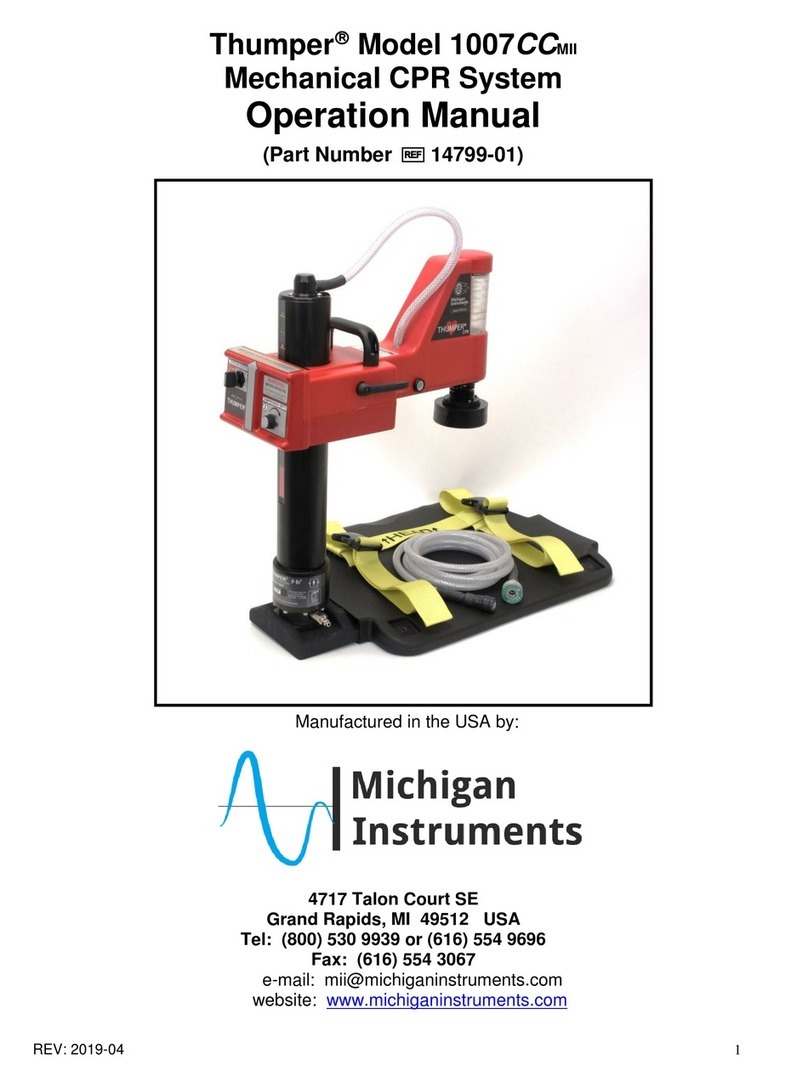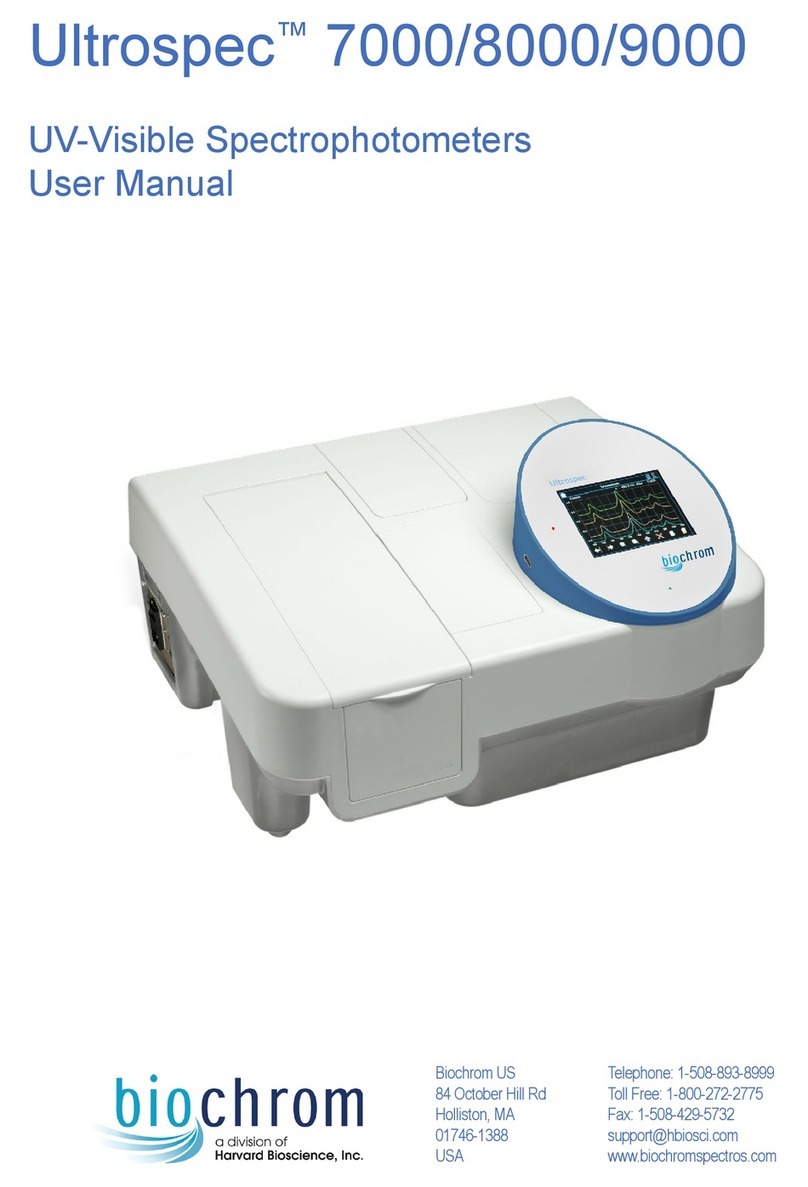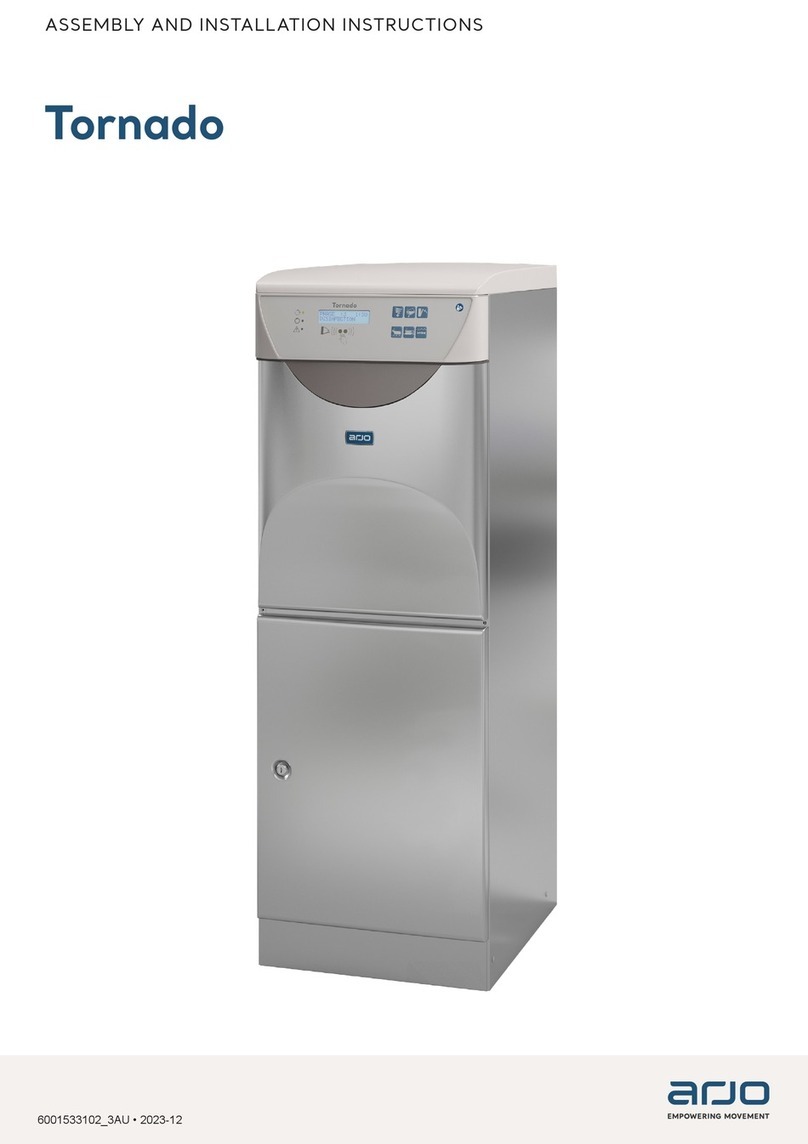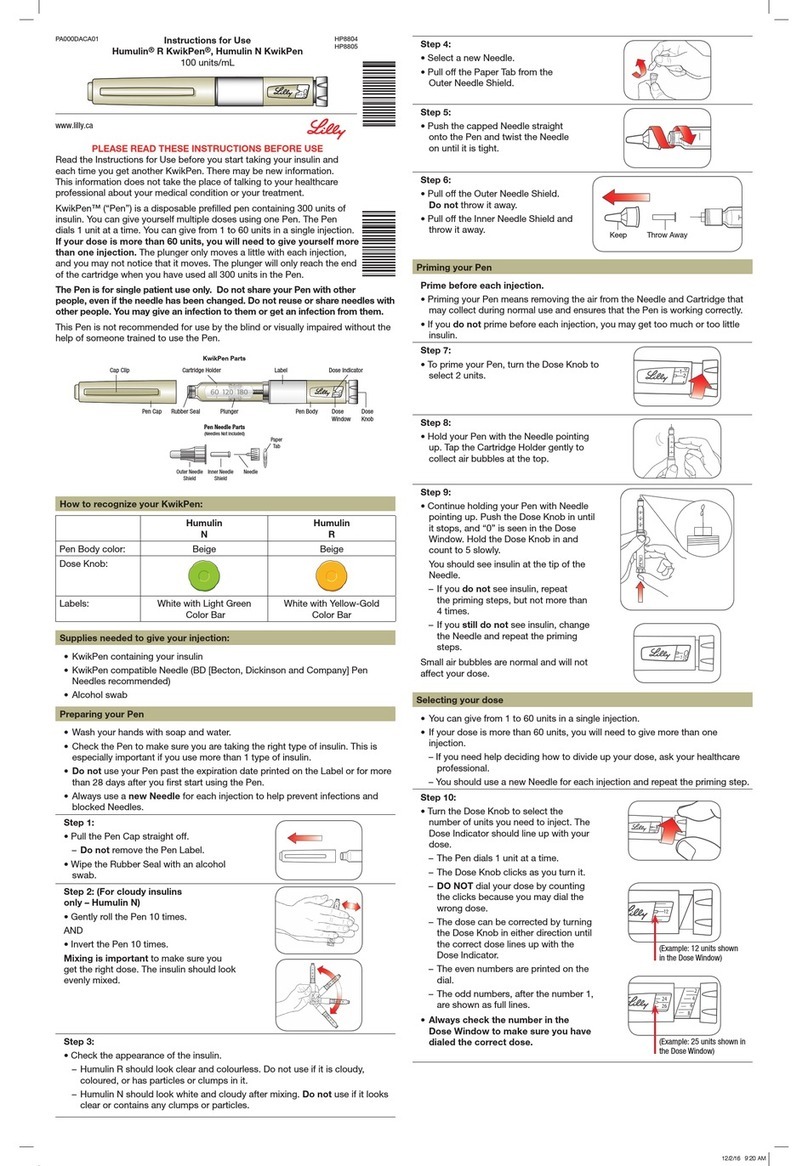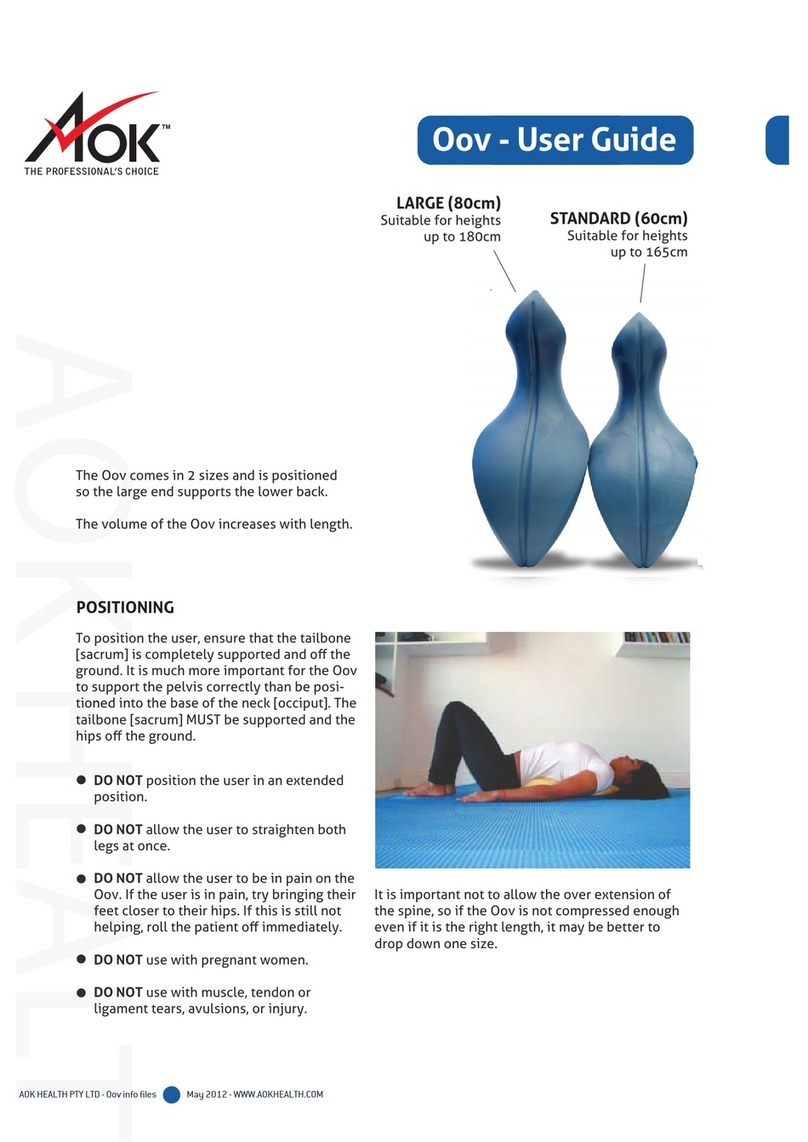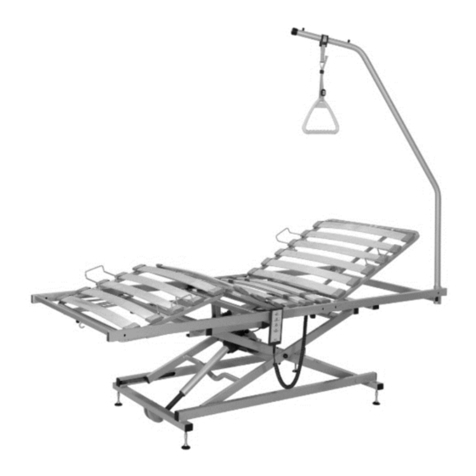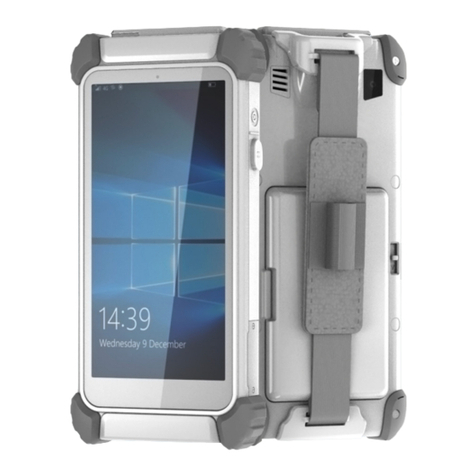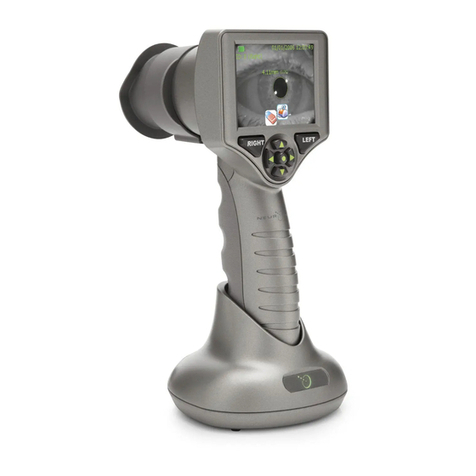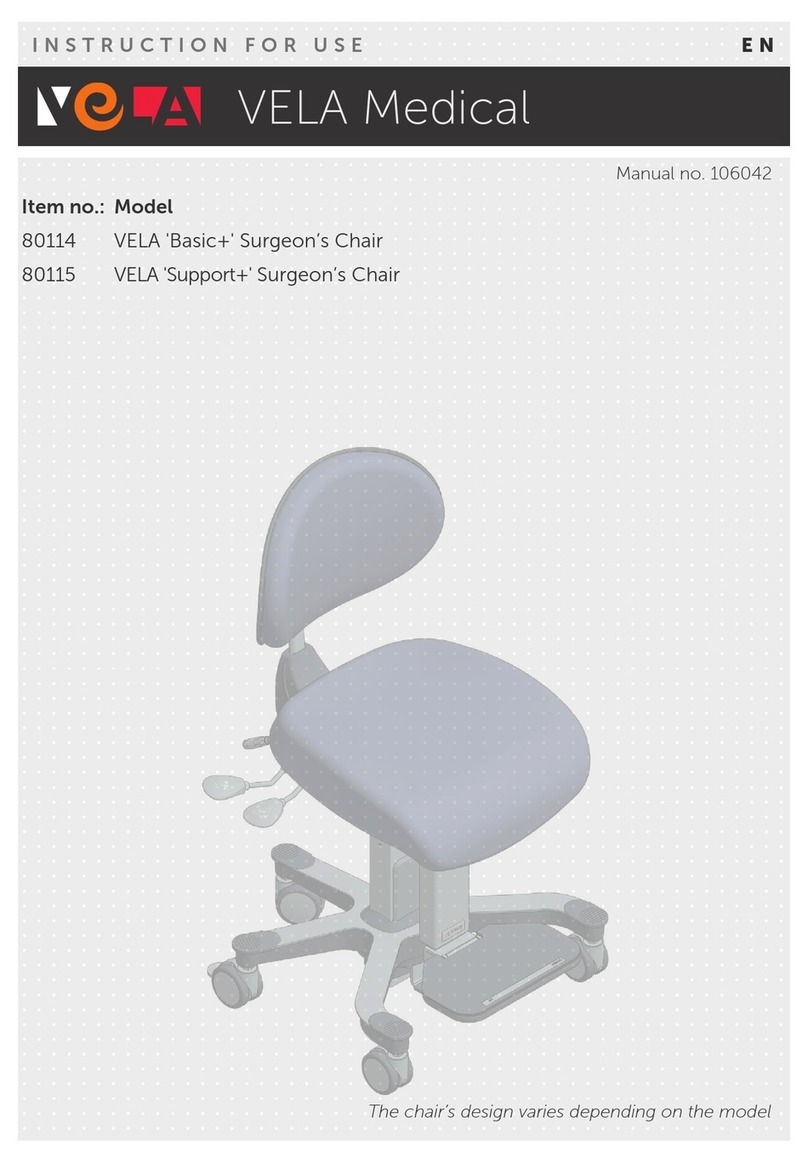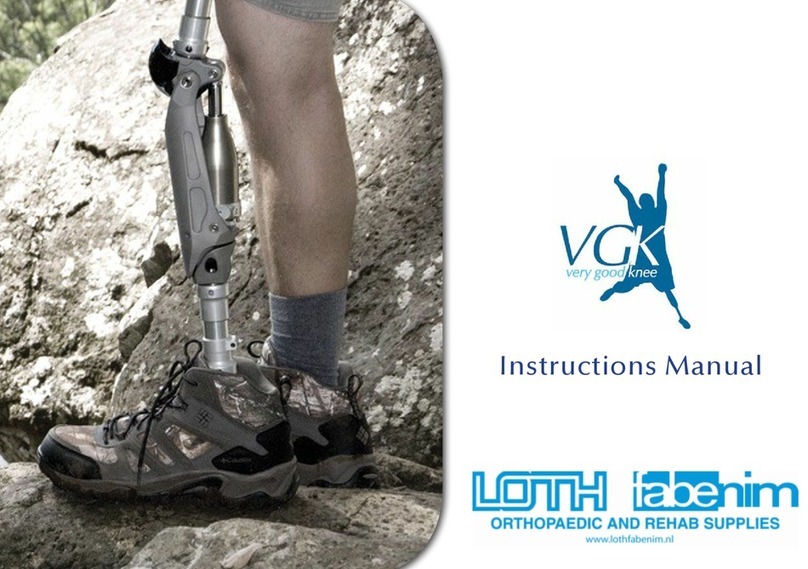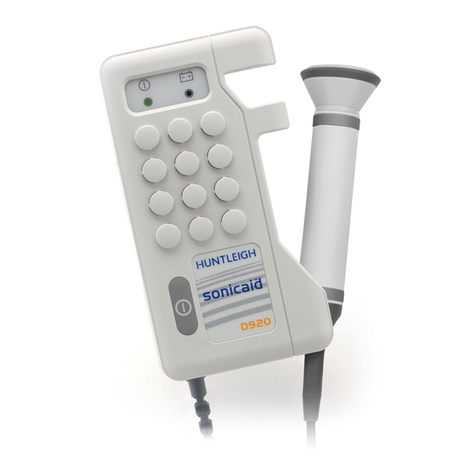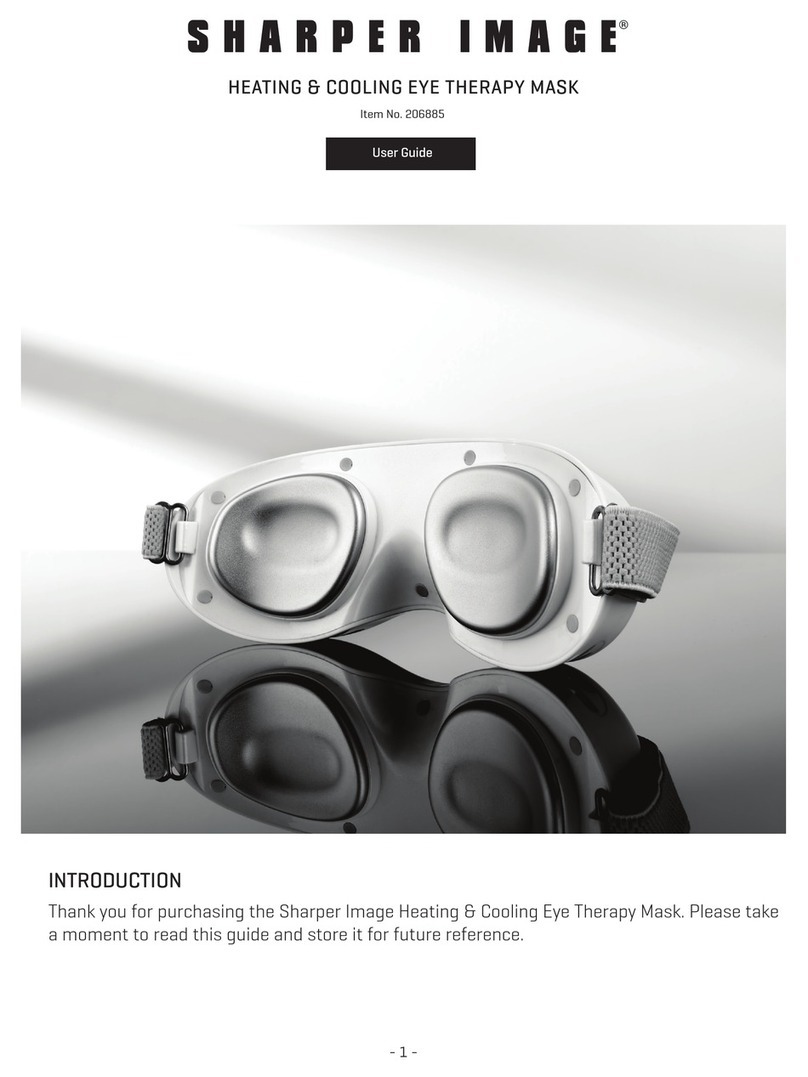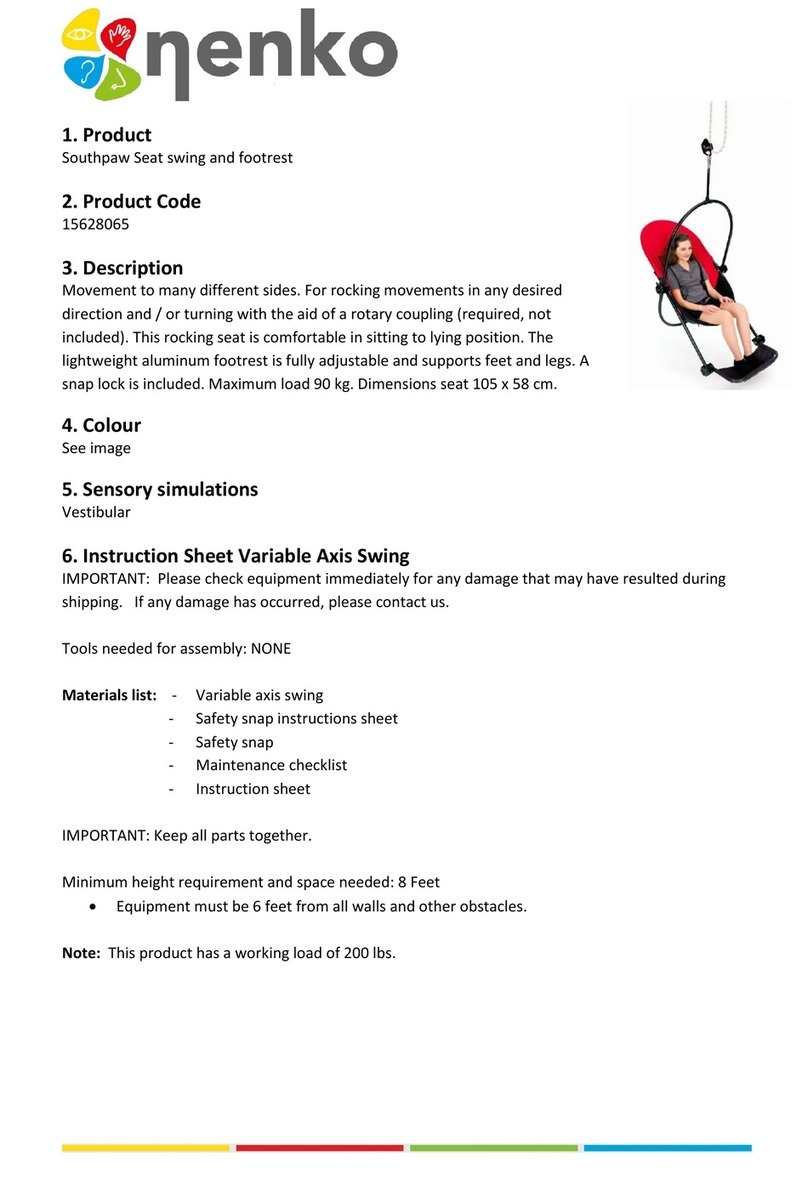Michigan Instruments LIFE-STAT 1008MII User manual

REV: 2019-04 1
Model 1008MII
Mechanical CPR System
Instructions for Use (IFU) Manual
(Part Number h16005)
Manufactured in the USA by:
4717 Talon Court SE
Grand Rapids, MI 49512 USA
Tel: (800) 530-9939 or (616) 554-9696
Fax: (616) 554-3067
e-mail: mii@michiganinstruments.com
website: www.life-stat.com

REV: 2019-04 2
Copyright
PROTECTED UNDER ONE
Copyright © OR MORE OF THE
FOLLOWING U.S. PATENTS:
6,171,267 5,743,864
M
Michigan Instruments
4717 Talon Court SE
Grand Rapids, MI 49512 USA
All rights reserved
Symbols used on the device and in this IFU:
Symbol
Meaning
Symbol
Meaning
M
Manufacturer –Name/Address
information. Date of manufacture
appears under symbol in YEAR-MO
format (on device).
Y
Caution - Attention: Consult
Accompanying Documents. Operators
are to refer to information provided with
the device.
Direct Current –(9V indicated)
Defibrillation Protection
(Type BF Patient)
i
Consult Instructions for Use –
additional information available.
f
Serial Number
Special Disposal Required
Gas Supply (operating range indicated)
Read Operator’s Manual or
Instructions For Use (IFU).
D
Do Not Reuse - Dispose after use.
h
Catalog Number –Part number reference.

REV: 2019-04 3
Contents
1-Introduction ..........................................................................................................................................................................5
1.1 The Life-Stat®Model 1008MII Instructions for Use (IFU)..............................................................................................5
1.2 Use of Warnings, Cautions, and Notes ..........................................................................................................................5
1.3 Indication for Use ..........................................................................................................................................................6
1.4 Contraindication.............................................................................................................................................................6
1.5 Benefits of Mechanical CPR..........................................................................................................................................6
1.6 General Warnings and Cautions ....................................................................................................................................7
2-Product Description..............................................................................................................................................................9
2.1 Life-Stat®Cardiopulmonary Resuscitator......................................................................................................................9
2.2 General Description.......................................................................................................................................................9
2.3 Life-Stat®System Components and Accessories...........................................................................................................9
2.3.1 Life-Stat® System..................................................................................................................................................10
2.3.2 Controls and Labeling...........................................................................................................................................11
2.3.3 Battery Power Supply ...........................................................................................................................................13
2.4 Important Safety Features............................................................................................................................................14
2.5 The BackBoard.............................................................................................................................................................15
2.6 Mobile Oxygen Carrier (MOC), or Appropriate Wall Access Adapter .......................................................................15
2.7 The Carrying/Storage Case..........................................................................................................................................16
3-Setup and Operation ...........................................................................................................................................................16
3.1 Precautions...................................................................................................................................................................17
3.2 Recommendations........................................................................................................................................................18
3.3 Positioning the Patient .................................................................................................................................................19
3.4 Life-Stat®Deployment.................................................................................................................................................20
3.4.1 Life-Stat®Setup:...................................................................................................................................................20
3.4.2 Life-Stat®Application to the Patient: ...................................................................................................................21
3.4.3 Determine Compression Depth:............................................................................................................................22
3.4.4 Life-Stat®Activation: ...........................................................................................................................................22
3.4.5 Life-Stat®Ventilator- Patient Demand Valve (PDV) Activation: ........................................................................24
3.4.6 Procedure to Interrupt (Suspend) Compressions:..................................................................................................25
3.5 To Remove the Life-Stat®from the Patient:................................................................................................................25
4-Storage and Shipping..........................................................................................................................................................27
4.1 Storage.........................................................................................................................................................................27
4.2 Shipping.......................................................................................................................................................................27
4.3 Disposal .......................................................................................................................................................................27
5-Care, Cleaning, and Disinfection........................................................................................................................................29
5.1 General Care................................................................................................................................................................29
5.2 Avoiding Contamination..............................................................................................................................................29
5.3 General Cleaning .........................................................................................................................................................29
5.4 Disinfection Guidelines ...............................................................................................................................................29
5.5 Cleaning and Disinfecting the Patient Demand Valve.................................................................................................29

REV: 2019-04 4
5.6 Mobile Oxygen Carrier (MOC) ...................................................................................................................................31
5.7 Periodic Preventive Maintenance.................................................................................................................................31
5.8 Shift Check ..................................................................................................................................................................33
5.9 Functional Check.........................................................................................................................................................35
5.10 Troubleshooting Guide: .............................................................................................................................................37
5.11 Life-Stat®Model 1008MII Detailed Specifications......................................................................................................38
5.12 Electromagnetic Environmental Declaration. ............................................................................................................39
5.13 Parts List (Life-Stat®) ................................................................................................................................................42
6-Warranty and Factory Service Information ........................................................................................................................43
6.1 Model 1008MII Life-Stat®Cardiopulmonary Resuscitator Warranty Agreement..........................................................43
6.2 Purchase Records.........................................................................................................................................................43
6.3 Factory Service Policy.................................................................................................................................................44
6.3.1 What to do if the Life-Stat®CPR System requires service:..................................................................................44
6.3.2 Additional Terms:.................................................................................................................................................45
6.4 Warranty Repairs.........................................................................................................................................................45
GLOSSARY..........................................................................................................................................................................47
TERMS USED IN MANUAL...............................................................................................................................................47

REV: 2019-04 5
1-Introduction
Federal law restricts this device to sales to, or on
the order of, a licensed medical practitioner.
1.1 The Life-Stat®Model 1008MII Instructions for Use (IFU)
NOTE: The purpose of this manual is to explain the use, care, and user
maintenance of the device, not to teach cardiopulmonary resuscitation.
Proper use of the Life-Stat®requires a thorough understanding of this manual, appropriate training,
and adequate practice with the device. This manual contains important information on all aspects of
operating and maintaining the device. After a complete review, use it as a guide to practice with the
Life-Stat®until completely confident and comfortable with its operation.
Keep this manual in a location where it is available for quick reference. The format is designed to
allow each section to be scanned quickly for answers to specific questions. The Table of Contents can
be used to find major headings and topics. For example, the Setup and Operation section will guide a
new user through the proper procedures for using the equipment. The Care, Cleaning, and
Disinfection section can be used to plan an effective preventive maintenance program.
1.2 Use of Warnings, Cautions, and Notes
As used in this manual-- Warnings, Cautions and Notes are depicted as:
WARNING: intended to alert users to the possibility of injury,
serious adverse reaction, or death associated with use or misuse.
CAUTION: intended to alert users to the possibility of a problem
associated with use or misuse.
NOTE: intended to alert users to particularly useful information.

REV: 2019-04 6
1.3 Indication for Use
The Life-Stat®CPR System is used to perform Cardiopulmonary Resuscitation (CPR) on adult
patients only in cases of clinical death, as defined by a lack of spontaneous breathing and pulse.
WARNING: The Life-Stat®is to be used solely for the purpose of
delivering mechanical cardiopulmonary resuscitation (CPR) in
accordance with established American Heart Association (AHA)
guidelines. It is to be used in cases of clinical death to provide CPR
support under the direction and control of a licensed physician. Use of
this device for any other purpose is strongly discouraged.
1.4 Contraindication
There are situations where CPR is not the appropriate method of intervention. Familiarity with
accepted medical practices in your area is very important. Always consult local protocol for the
proper integration of the Life-Stat®into your cardiac arrest management regimen of care.
CAUTION: Current American Heart Association guidelines do not
recommend the use of mechanical CPR on infants or children.
WARNING: This device is to be used by personnel knowledgeable in
safe and effective first response (first aid) practices and techniques.
Always observe safe and proper first aid procedures in the application
and use of this device.
1.5 Benefits of Mechanical CPR
With the purchase of the Life-Stat®CPR System, you join thousands of health care professionals
worldwide who benefit from the many advantages of mechanical CPR. The Advanced Cardiac Life
Support Manual published by the American Heart Association, describes some of the benefits of
mechanical CPR devices as follows:
"... they can 1) standardize the technique of CPR, 2) eliminate user fatigue, 3) free
trained persons to participate in the delivery of ACLS when there is a limited
number of rescuers, and 4) assure adequacy of compression when a patient requires
continued resuscitation during transportation."

REV: 2019-04 7
1.6 General Warnings and Cautions
WARNING: Improper application of this equipment can cause serious
injury. This manual must be thoroughly understood in order to use this
device correctly and to avoid possible serious injury.
WARNING: Federal law restricts this device to sales to, or on the order
of, a licensed medical practitioner.
WARNING: As this device is powered by compressed medical grade
Oxygen, safe Oxygen handling practices and procedures are to be
implemented with its use.
CAUTION: It is very important to follow the instructions for
preventive maintenance and cleaning procedures after each use. They
are found in the Care, Cleaning, and Disinfection section of this
manual.
CAUTION: Submersion of the Life-Stat®in water will cause
infiltration of water into internal critical parts. This may lead to
corrosion and eventual operational failure. This includes inadvertent
injection of water as from a contaminated Oxygen cylinder or
humidified gas supplies.
CAUTION: Infiltration of foreign material into the Life-Stat®may
cause operational failure.
CAUTION: When carrying the Life-Stat®or moving the Arm up or
down the Column, always use the Handle provided. Do NOT use the
hose spanning the Column and Arm as a handle as this will stress the
hose and clamps.

REV: 2019-04 8
(Blank Page Intentional)

REV: 2019-04 9
2-Product Description
2.1 Life-Stat®Cardiopulmonary Resuscitator
The Michigan Instruments Life-Stat®is the latest model of our portable, automatic cardiopulmonary
resuscitation (CPR) medical devices which have been in use since 1964.
2.2 General Description
The Life-Stat®system provides consistent CPR support for cardiac arrest patients under conditions
which might otherwise hinder the effectiveness of manual techniques. The Life-Stat®performs two
modes of CPR support in conformance with AHA CPR guidelines. In either mode, compressions are
delivered at a frequency of 100 or 120 per minute*.
•30:2 mode will provide thirty (30) chest compressions, then pause compressions to deliver two
(2) ventilations. This 30 to 2 pattern will repeat continuously.
•CCV mode will provide continuous compressions with asynchronous ventilations delivered at 9
or 10 breaths per minute*.
The Life-Stat®is a mechanical “automatic” CPR device that can be set up in seconds. The chest
compressor is powered by compressed Oxygen while timing is controlled by a 9V electronic circuit.
The device is electrically insulated, allowing it to be freely and safely used in conjunction with routine
patient monitoring, external pacing and defibrillation procedures. The Life-Stat®, once correctly
applied over the patient’s sternum, is designed to measure the patient’s anterior-posterior (A-P) chest
diameter and deliver the equivalent sternal deflection of 20% of that diameter.
NOTE: AHA Guidelines recommend for adult patients, a minimum compression
depth of at least 2" (5cm). If the A-P chest diameter number indicated on the Life-
Stat®is less than 5, then deliver compressions minimally to the depth indicated by
the -5- marking on the dome.
*-depending on version ordered. Devices set at 120 will have a serial number of LS-4000 or higher.
2.3 Life-Stat®System Components and Accessories
The Life-Stat®System consists of three major components:
•Life-Stat®(Arm/Column/Base Assembly)
•BackBoard (BackBoard/Shoulder Straps)
•Mobile Oxygen Carrier / appropriate O2wall access adaptor.
A fourth component, the Carrying/Storage Case is available to transport/store the device when not in
use.

REV: 2019-04 10
2.3.1 Life-Stat® System
The Arm and Column positions the Piston and Massager Pad correctly over the patient’s sternum. It is
designed to provide a sternal deflection percentage based on the patient A-P chest diameter. Sternal
deflection is nominally set to 20% of the A-P diameter. The depth of each chest compression is easily
monitored using the markings on the Dome surrounding the Piston. The Column also serves as a
storage tank that holds sufficient Oxygen to continue to drive the Life-Stat®for several compressions
during an Oxygen source change.
Piston
(inside Dome)
Massager
Pad
Handle
Arm
Lock
Dome
Sternal
Deflection
Number
A-P Diameter
Sternal Deflection
Number
Arm
Column
O2
Supply
Hose
Patient
Demand Valve
(PDV)
O2Supply Connector
Battery
Compartment
(1 of 2)
Base
The Life-Stat®System
Pressure
Indicator
BackBoard

REV: 2019-04 11
2.3.2 Controls and Labeling
The Life-Stat®controls are located on the back of the Arm.
Figure 6
1. SYSTEM CONTROL (Control#1): This membrane keypad is used to control the Life-Stat®. It
is comprised of 5 electronic buttons, described below.
START/ON button. Pressing this button will activate the electronic control module
and perform a self test. The green LED indicator next to the button will illuminate to
indicate that the unit is on after completion of a successful self test.
STOP/OFF button. Pressing this button will return the chest compressor piston to the
‘up’ position, turn off the ventilator and shut down the electronic control module.
30:2 button. Pressing this button will activate the 30 compressions to 2 ventilations
operating mode and the blue LED indicator next to the button will illuminate.
CCV button. Pressing this button will activate the Continuous Compressions/
Ventilations operating mode and the blue LED indicator next to the button will
illuminate.
PAUSE button. Pressing this button will return the chest compressor piston to the ‘up’
position and pause compressions. Ventilations will continue and the yellow LED
indicator next to the button will illuminate. To resume compressions, press the desired
mode button (30:2 or CCV).
LOW BATTERY indicator. The red LED indicator will illuminate when the battery
voltage is too low to sufficiently power the device. When the power level reaches a
critical stage, an auto shutdown will bring the chest compressor piston to the ‘up’
position; turn off the ventilator and the electronic control module.
Control Panel

REV: 2019-04 12
2. COMPRESSION DEPTH (Control #2): This control is used
for setting the depth of compression on the patient. The depth is
set to correspond to the measured A-P diameter shown on the
scale located on the back of the Column. As indicated by the
arrow, turn the knob clockwise to increase the compression
depth and counterclockwise to decrease compression depth.
NOTE: After the massager pad has been lowered to the patient's chest, the correct patient A-P
chest diameter is determined by locating the number on the back of the Column (A) just above
the Arm where the white arrows (B) are located. Set the compression depth to the
corresponding indicator number on the Dome (C) to match the A-P diameter number
indicated on the Column.
3. VENTILATION VOLUME (Control #3): This control
adjusts the tidal volume (0-1000mL) of Oxygen delivered to
the patient from the PDV. The tidal volume is increased with
a clockwise rotation and decreased with a counterclockwise
rotation. With the control in the fully counterclockwise
position, no (0mL) tidal volume is delivered.
WARNING: Before operation, ensure that all controls are in the “OFF” or
“decreased” (fully counterclockwise) position before connecting to an Oxygen supply
or placing the unit on the patient. By verifying the position of all controls the
operator is assured of proper operation.
A
B
B
C

REV: 2019-04 13
2.3.3 Battery Power Supply
The Life-Stat®electronic control module is powered by two (2) 9V alkaline batteries.
CAUTION: Do NOT use excessive force to install the battery in the tray. Ensure the
polarity is oriented per the label and to the diagram embossed on the bottom of the tray (+
on left, - on right). Failure to install either battery in the correct position will prevent the
device from operating and may lead to failure of the device which will void the warranty.
The batteries that power the electronic module are located on either side of
the Arm.
CAUTION: Only use batteries that conform fully to
IEC 60086-2 or ANSI C18.1M.
To install/replace the batteries:
1. To access the battery, place fingernail into slot
near bottom of the battery compartment and push
upwards slightly to release the tray.
2. Pull out the battery tray. Install the battery by
orienting it to the diagram. The battery tray is spring
loaded to keep the battery secure. Ensure the battery
is properly seated.
3. Re-insert the tray and push in until an audible click is heard ensuring the tray is properly seated
inside the compartment.
4. Repeat for the battery located on the opposite side.
Important Battery Information:
•Always use name brand batteries of the same brand and type. Never install generic and/or
differing brand batteries together.
•Always replace BOTH batteries with fresh new ones. Never install just one fresh battery and
leave a used battery in the opposite side.
•ALWAYS operate the device with BOTH batteries installed and of equal strength.
WARNING: Operating the device with only one battery installed is not advised. If
only one battery is installed and coincidentally removed during operation when
performing a “Hot Swap”, the device could possibly stop in a “piston down” position
requiring removal of O2 Supply Hose from the base of the device to release the
piston. ALWAYS OPERATE the device with BOTH BATTERIES INSTALLED.
•Always use 9V alkaline batteries. Do not mix battery types.
•Do NOT use re-chargeable batteries of ANY type.
•The battery trays are not tethered to the compartments. Take care when removing them to
ensure they are not lost or damaged.

REV: 2019-04 14
•If stored for extended periods with batteries installed, inspect both batteries prior to use to
ensure they have not corroded.
•Dispose of used batteries properly.
2.4 Important Safety Features
Changing a battery during operation -- Should a low battery level occur during resuscitation
efforts, either battery may be removed and replaced, (one at a time), from its compartment and a fresh
battery can be “hot swapped’ providing uninterrupted CPR.
WARNING: The “Hot Swap” should ONLY be performed when it is KNOWN
that both batteries are installed and have equal energy. If no battery power is
available, the device will stop without resetting. This could result in a “piston
down” position requiring removal of the O2 Supply Hose from the base of the
device to release the piston.
To “Hot Swap” the battery
1. Remove only one battery tray from either side of the Life-Stat®allowing the battery installed
on the opposing side to continue to power the device.
2. Remove the used battery by pushing it back against the retaining spring and lifting up.
3. Insert a fresh battery in its place ensuring it is oriented properly (+ on left, - on right) per the
diagram embossed on the bottom of the tray.
4. Re-insert the tray until a click is heard to ensure it is seated properly.
5. Discard the used battery appropriately when convenient.
The opposing battery may be ‘hot-swapped’ also following the above steps at this time. If it is not
replaced immediately, install a fresh battery as soon as possible to ensure both batteries are fresh.
After replacement of either or both batteries, the LOW BATT LED will remain illuminated for
approximately 2 - 5 minutes.
Auto Shutdown feature-- When the batteries reach a critical low level condition, the Life-Stat®will
initiate an auto shutdown procedure. If the Life-Stat®is not physically turned off via the STOP/OFF
button on the System Control (#1) keypad –or- the batteries are not ‘hot-swapped’ out as explained
above, the compressor piston will return to the ‘up’ position, the ventilator will turn off, and the
electronic control module will automatically shut down.
Also, if the unit is turned on (the START/ON button is pressed) but no CPR mode (30;2 or CCV) is
selected within 16 minutes, the device will shut down to conserve the batteries.
Service Interval Indicator—After the Life-Stat®has delivered over 1,000,000 (1 million) cycles, the
START/ON LED indicator will flash. It is recommended to return the device to the factory for service
after this occurs. The Life-Stat®will continue to function, however diminished performance may
result if the recommended service is not performed to replace potentially worn components.

REV: 2019-04 15
2.5 TheBackBoard
The BackBoard is intended for either manual or mechanical CPR. It is designed to provide a firm,
non-rebounding surface upon which CPR can be performed, and introduces a slight hyperextension of
the patient’s neck to facilitate upper airway management. It allows use of the Life-Stat® on either side
of the patient. Two shoulder straps help immobilize the patient securing them to the BackBoard. The
cross strap helps to keep the shoulder straps separated and indicates the position of the head relative to
the BackBoard.
NOTE: Optimal Life-Stat®CPR performance requires use of the BackBoard.
2.6 Mobile Oxygen Carrier (MOC), or Appropriate Wall Access Adapter
The Life-Stat®is equipped with an O2Supply Hose used to connect the device to a source of compressed
medical Oxygen. It incorporates couplers on each end and a check valve to retain the Oxygen during a
source change. Wall adapters are available that connect to the O2Supply Hose to allow connection to the
various and most common hospital (and ambulance) Oxygen pipeline systems.
The Mobile Oxygen Carrier is an Oxygen tank carrier, available in two configurations, which provide
constant pressure and high flow source gas for the Life-Stat®and an additional DISS outlet. It is
designed to power the Life-Stat®whenever the device is in use where no Oxygen pipeline source is
available (for example, when transporting a cardiac arrest patient from the scene to the ambulance and
from the ambulance to the hospital). One of the two outlets is dedicated to accept the Life-Stat® O2
Supply Hose, while the other DISS outlet is available to supply other Oxygen-driven devices. MOC
regulator(s) are preset to satisfy Life-Stat® requirements.
The BackBoard
Shoulder
Straps
Cross Strap

REV: 2019-04 16
Single tank carrier for “DD” carbon fiber
cylinder (Regulator available separately)
Dual tank carrier for “D” or “E” aluminum
cylinders
(Cylinders not included)
2.7 The Carrying/Storage Case
The Carrying/Storage Case is constructed of a durable nylon. The Life-Stat®, O2Supply Hose and
code-related supplies are stored in the Case in a manner which permits immediate access to the device
and facilitates easy setup at an emergency site.
Carrying/Storage Case
Mobile Oxygen Carrier (MOC)

REV: 2019-04 17
3-Setup and Operation
3.1 Precautions
Before setting up and using the Life-Stat®, there are several important precautions that must be
observed at all times.
1. The Life-Stat®must only be used in cases of clinical death as defined by lack of spontaneous
breathing and pulse.
2. Manual CPR should be started on the patient immediately. Do not postpone CPR while waiting
for the Life-Stat®. The Life-Stat®can be easily set up and applied to the patient without
interrupting manual CPR efforts.
3. The Life-Stat®may be used in all cases with adult patients where manual CPR would normally be
initiated. However, there are situations where CPR is not the appropriate method of intervention.
Familiarity with accepted medical practices in your area is very important.
4. Personnel certified in manual CPR must always be present to monitor the patient during Life-Stat®
operation in the event of a mechanical failure.
5. When transporting a patient with the Life-Stat®in operation using the BackBoard, ensure the patient is
secured snugly to the BackBoard using the provided shoulder straps. Also, ensure the patient is
properly secured (using retention straps) to the stretcher as well. Failure to do so can allow the Life-
Stat®and BackBoard to shift position on the patient possibly causing the Massager Pad to wander off
of the patient’s sternum.
6. When applying the Life-Stat®to an obese patient, place the arm of the patient around the Life-Stat®so
that the Column is positioned near the arm pit of the patient. This will better facilitate positioning the
Massager Pad directly over the patient’s sternum.

REV: 2019-04 18
3.2 Recommendations
It is recommended that the Arm/Column of the Life-Stat®
be attached to the Base while stored in the Carrying/Storage
Case.
Additionally, the Arm should be positioned over the Base so
that it is perpendicular to the O2Supply Connector located at
the bottom of the Column. Lower the Arm until the white
arrow is positioned at the -4- location on the Column and
lock in place.
By doing so, the Life-Stat® is ideally positioned to expedite
removal from the Carrying/Storage case and application to
the patient.
When placing the BackBoard under the patient, ensure the cross strap is positioned under the patient's
neck. Do not position the cross strap over the neck of the patient.
Training with a CPR Manikin can be beneficial in becoming familiar with:
✓Setup on the patient using the BackBoard
✓Transitioning from manual CPR to mechanical CPR
✓Setting the compression depth and delivering ventilations
✓Interventions such as pausing operation to monitor the patient
✓Performing the ‘hot swap’ of a battery
O2Supply
Connector
Correct Cross
Strap Position

REV: 2019-04 19
3.3 Positioning the Patient
The following steps are provided as a recommendation.
1. When applying the BackBoard, “Log roll” the patient into position, taking care to keep the cervical
spine immobilized.
WARNING: When moving a patient in cases of suspected C-spine injury,
always support the patient’s head in a neutral position.
2. Place the BackBoard under the patient orienting the head of the patient in the direction indicated by
the HEAD marking on the cross strap. Ensure the cross strap is positioned under the patient's neck.
Connect the retaining straps over the shoulder and under the arm pit of the patient, then buckle and
tighten the straps securely on both sides of the patient.
3. Secure the patient to the spine board with retention straps at the forehead, hips and feet.
WARNING: Do not place retention straps or other restraints over the
patient’s abdominal area. Tight garments around the abdomen should be
removed or loosened.
4. Manual CPR can begin on the patient immediately. There is no need to postpone CPR while
waiting for Life-Stat®deployment and application to the patient.

REV: 2019-04 20
3.4 Life-Stat®Deployment
3.4.1 Life-Stat®Setup: A. Remove the Life-Stat® from the Case.
B. Ensure the System C. Ensure Controls (#2) &
Control (#1) is OFF. (#3) are both turned fully
counterclockwise.
D. Attach the Breathing Hose/Non Re-breathing valve (and mask,
if used) to the PDV.
E. Ensure the Oxygen source is energized then attach the O2
Supply Hose to the Oxygen source. Pull the collar back from
the O2Source-end connector, press firmly onto the male
connector of the Oxygen source, then release the collar to
secure the connector. Pull gently on the hose to ensure a secure
connection.
F. Attach the opposite end of the hose to the Life-Stat®
O2Supply Connector by inserting the hose
connector while slightly turning it at the same time
to align the hexagons, and then press firmly to attach. Pull
gently on hose to ensure a secure connection. Do not press the
release button while attaching the connector. Only press the
release button to disconnect the connector.
G. Verify that the green Pressure Indicator located on the top of the
column shows an adequate input pressure is available.
Press for
OFF
Table of contents
Other Michigan Instruments Medical Equipment manuals
Popular Medical Equipment manuals by other brands

Dräger
Dräger CPS 7900 Instructions for use
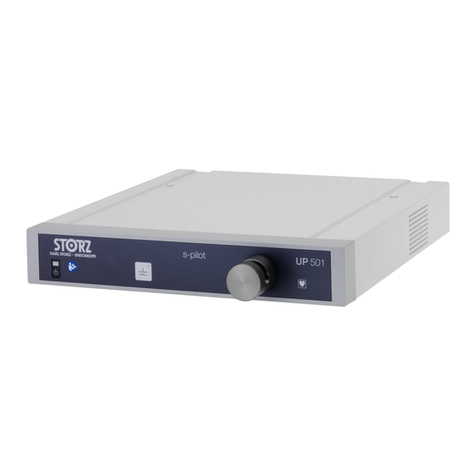
Karl Storz
Karl Storz UP 501 S-PILOT instruction manual

Owandy
Owandy Visteo Installation and user manual
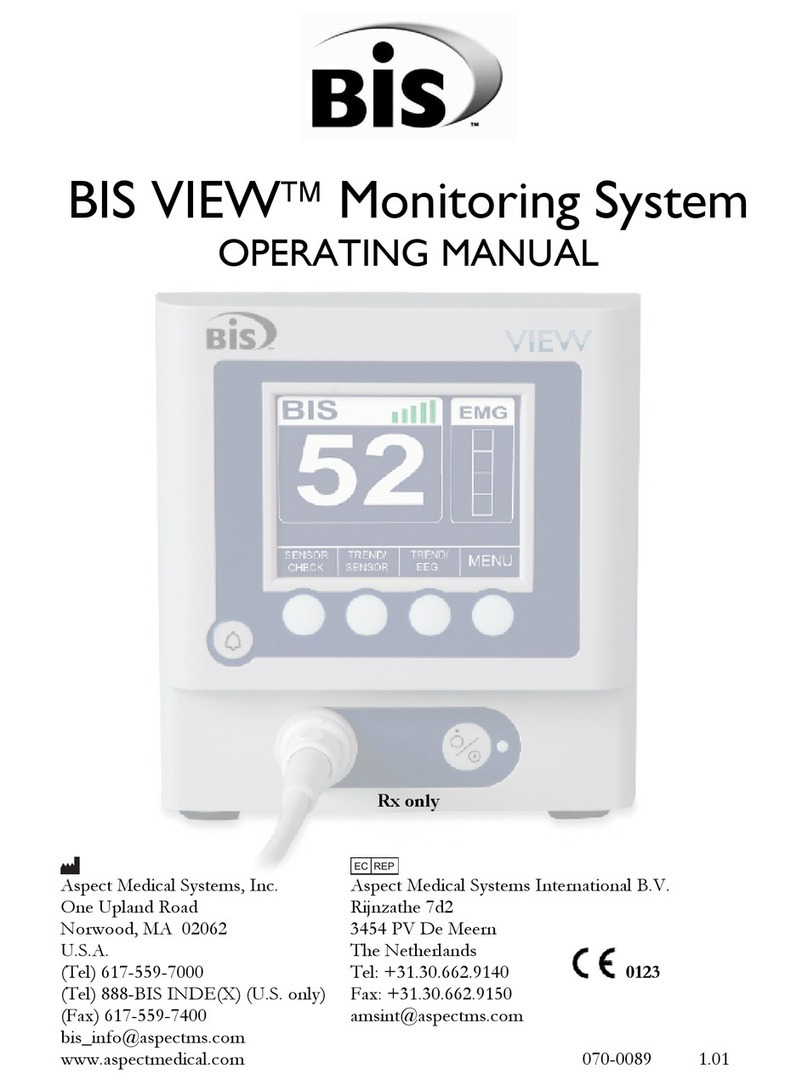
Aspect Medical Systems
Aspect Medical Systems BIS VIEW operating manual
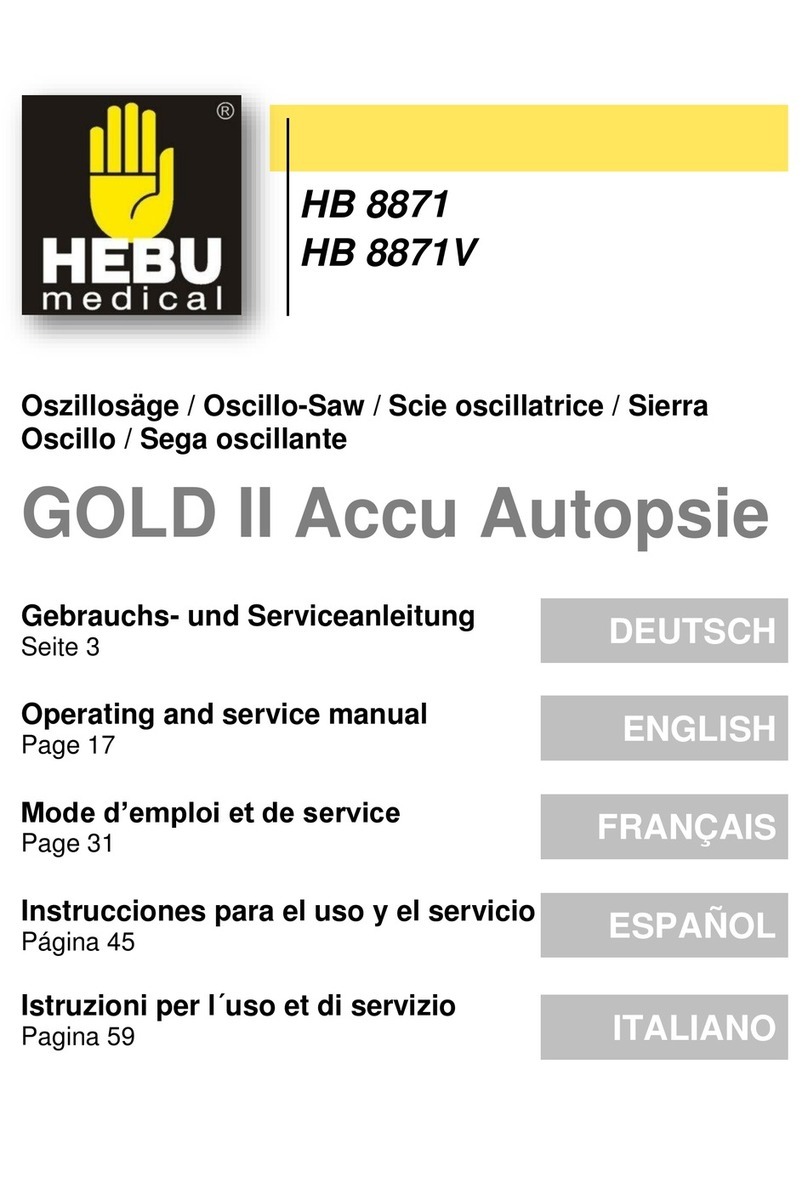
HEBU medical
HEBU medical GOLD II Accu Autopsie HB 8871 Operating and service manual
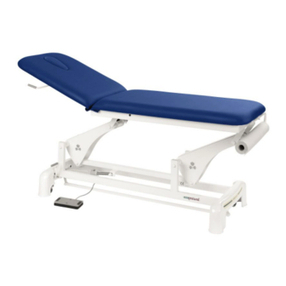
ECOPOSTURAL
ECOPOSTURAL C3553 instructions

